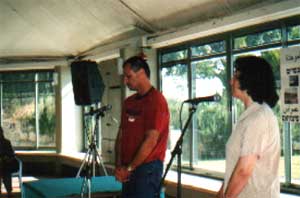On Saturday, June 7, 2003, 150 people gathered in the auditorium of Neve Shalom ~ Wahat al-Salaam to commemorate the 36th year of the occupation — the territories in the "Six Day War" as they are called by Israelis or "Naqsa '67" as they are called by the Palestinians, and in particular to commemorate the tragic event that took place not far from here in the area of Latrun.
Three groups came together to organize the event: The Committee of the Three Villages, a Palestinian organization that works for the recognition of the injustice and for its repair through the return of the refugees to their villages and the return of their lands; Dumiya – Saqina, the pluralistic spiritual center of Neve Shalom, which works to advance the goals of the binational community by providing a framework for spiritual, cultural, and educational activities so as to advance listening, understanding, and reconciliation between Arabs and Jews; and Zochrot.
In this time, while a physical wall of separation is being built between the nations, we, Jews and Arabs, choose to act in favor of recognition of the memory of the Nakba of the Palestinian people and call for justice to be granted to the refugees and the internally displaced in favor of reconciliation and the advancement of peace and equality.
We chose to tell the story of the three Latrun villages and to post our signs because their stories are an example of Israel's policy which chooses to deny and erase it. On the lands of the village "Park Canada" an entire park was created, full of signs, visited by thousands of vacationers, but the Palestinian history of the place is not mentioned. The signs tell the far-off history all the way back to the Romans.
The first part of the day was devoted to listening to testimonies from people who were part of the tragedy from both sides, on one side refugees and on the other side Israelis, and to watching a filmed testimony. In the second part the crowd was invited to continue to the area of the villages, which since the 1970s has been called Park Canada, and there, at the center of what was once the village of Yalu, we held a ceremony and posted signs designating the name of the village and the number of residents who lived there before the expulsion.
Description of the event by Diana and Dorit, organizers no behalf of Neve Shalom ~ Wahat al-Salaam:
As we were dealing with the final preparations in the auditorium, a car arrived with representatives of the three villages. The people arrived from their current place of residents in the West Bank (near Ramallah). Although Ramallah is only about a half hour away, the people drove four hours on dirt roads bypassing roadblocks. We were happy and moved to welcome them, and it seems that they were also very moved as well.
Gradually the auditorium filled up with a large audience, among them a number of people who were in activities on behalf of the residents of the villages: such as members of Kibbutz Nachshon and monks from the neighboring Latrun monastery. Following the opening remarks of the organizers, the representatives of the villages arose one after another and told their stories. The entire program was carried out in two languages with excellent simultaneous translation by Tagrid Shabita.
The first speaker was Mr. Nihad Abu Gosh, born in the village of Imwas . Nihad was the principal of the high school of the three villages in his 30s at the time of the occupation and expulsion. Today he is the Chair of the Board for the three villages. Nihad expressed his deep sorrow that he could not invite those present to sit with him and drink coffee in his village of Imwas , and the sadness that he feels for the residents of the villages who were expelled from their homes for not fault of their own. "True peace is a just peace, true peace is based on mutual recognition of the right of both peoples to live on this land one beside the other." Later he turned to friends from Kibbutz Nachshon who he knew as a neighbor before 1967 and said, "You can testify that we were good neighbors – what did we do to deserve this?"
The second representative of the Committee of the Three Villages was Mr. Ahmed Abu Alrob, born in the village of Yalu and an active member of the committee. "People lost all their belongings – turned our lands into a nature reserve." Ahmed Abu Alrob talked about the growing longings in the children of the second generation of refugees. About the children who also learn to aspire to a life of peace, and he turned to the audience with the request to help return them to their villages and to promote justice for their cause.
The third representative of the committee was Mr. Ismail Zayid, a second generation refugee. Ismail spoke about the stories that he heard from the home of his father, who was born in Beit Nuba. The stories of dancing and songs during the harvest and the picture of the women of the village around a well, wearing dresses embroidered with colored silk. Ismail also spoke about the aspiration to return to the villages and to live in peace on their land.
We heard a testimony from the other side from Amos Keinan, who took part in the occupation of the three villages and in the expulsion of the residents, as a solider in the Israeli military. Keinan spoke of a peace club he was involve with in Paris , of Jews and Palestinians who took an anti-imperialist and pro-peace stance. The group was founded by the philosopher Henri Courier.
Following this short introduction Keinan read the report that he had written on June 10, 1967.
Summary of the report:
A decision was made to bomb the three villages for strategic and security purposes. The orders were to comb the houses of the village, to take every armed person for imprisonment and to allow people who were not armed to gather their belongings and leave for Beit Sira, a neighboring village. We took positions at the entrance to the village in order to prevent people who were trying to return to their village from re-entering, and we shot bullets above their heads in order to move them away... With the blow of one bulldozer, the cypress and olive trees were uprooted. Within 10 minutes the house was in ruins, on top of the small number of items and property that were inside. After three houses were destroyed the first procession of refugees arrived from the direction of Ramallah, we didn't shoot in the air and the Arab speakers approached them to inform them of the orders. There were old people who could barely walk, old women mumbling, babies in their mothers' arms, young children. The children cried and pleaded for water, the procession raised white flags. We told them to go to Beit Sira. They said every place they went they were turned away, and they are not allowed to enter anywhere. That they had been walking for four days, without food, without water, and that a few of them had died. They asked to return to the village and said it would be better if we killed them.After listening to the report we remained silent as Nihad Abu Gosh of Imwas could not contain his emotion and with tears in his eyes recounted the difficult moments. "I was only 31 years old then. I remember that we were told to move immediately without being able to take a thing, not even shoes, old people were buried under the ruins. There were no combatants among us and we were not able to defend our homes."
After a short break we moved to another hall for a slide show of images by the photographer Yosef Hochman. Yosef Hochman was a member of Kibbutz Harel in 1967. A few days before the war sheep were stolen from the kibbutz because they heard about the occupation of the territory and a few members of the kibbutz decided to go out in a jeep to look for the sheep. At Imwas, Yosef joined them with a camera, and he returned the next day as well. Although the sheep were never found they succeeded in documenting the occupation, the destruction, and the expulsion. Yosef screened the photographs, talked about what he had seen and answered questions. The photographs on the screen spoke more than any description. Some of the images showed the villages before the destruction, beautiful stone houses, fruit gardens, and decorative trees. Some of the photographs illustrated the destruction itself. They showed bulldozers raising dust, during the destruction in some of them the refugees could be seen; a procession of men, women, children, and the elderly. One of the children held a white flag.
After another short break all those present were invited to join a long procession of cars that descended to Latrun to the area of the three villages. The lands of Imwas reached almost up to the Latrun monastery. After we passed by the Imwas cemetery we entered the gates of the park that was built with the contributions of Canadian Jews who apparently did not know about the painful history of the place. A few years ago Canadian television aired a documentary film on the subject which raised many reverberations in and led to the request to change the name of the park.
We continued along the narrow road, along the road we saw curbstones that indicated the existence of an ancient road. This was part of the main path that connected between the village and led to Ramallah. Soon after we came upon a breathtaking view of the orchards of Beit Nuba and the Mavo Choron settlement that was built on the lands of Beit Nuba. Finally we reached the place that greeted us with a large sign in Arabic and Hebrew: "Welcome to Yalu Village Center ." We stood among grape vines and trees of pomegranate, almond, and date, and at the side of a 20-meter-high palm. On an improvised stage, through sunset, we heard more testimonies from two of the refugees who have worked at the Latrun monastery since that time. One, Abdelfatah Khalil, and the other, Ahmeh Ali Abu Samra.
Neve Shalom resident Michal Zak spoke of the importance of recognizing the right of return, on the need for changing racist attitudes that prevent recognition of the rights of Palestinians to exist beside Jews as citizens having equal rights, and on the need to recognize injustice and to start a dialogue on the right of return in the Jewish-Israeli public. Michael said that by doing this, we can spur a process founded on justice and repair, and we can contribute to changing the character of the state and changing Israeli society into a more just, egalitarian, and ethical society.
The last speaker was Dr. Zuhir Sabag, a sociologist and lecturer at Bir Zeit University . Dr. Zuhir shared with us the daily experiences of himself and his family, who live in the territories occupied by . Dr. Sabag gave a short lecture surveying the history of what he called ethnic cleansing. Sabag quoted from the study of Zionist historians Arie Itzhak, who reports 110 massacres in 1948, and Benny Morris, according to whom 370 Palestinian villages were destroyed (others claim more than 400). The reason they were destroyed was to prevent residents from returning. The idea that sees 'natives' as irrelevant is one that typifies colonial regimes, of which is an example.
At the close of the event we posted signs in the area, each designating the name of the villages and a number of details about it. Some people dug, others brought water from the well to mix with sand to create the concrete mold. More signs were posted at the Imwas and Yalu cemeteries. The signs remained standing for about two days.
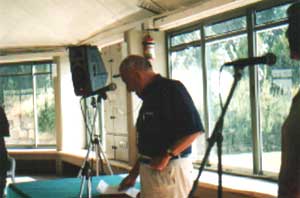
Latrun Tour 2003 (1)
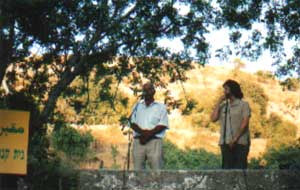
Latrun Tour 2003 (3)
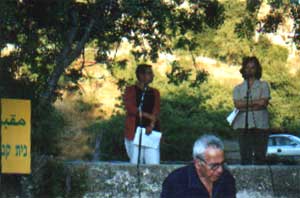
Latrun Tour 2003 (2)
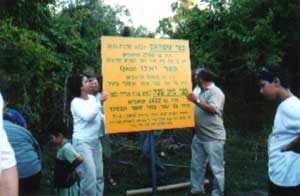
Latrun Tour 2003 (4)
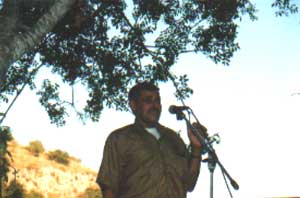
Latrun Tour 2003 (5)
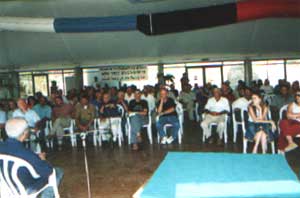
Latrun Tour 2003 (6)
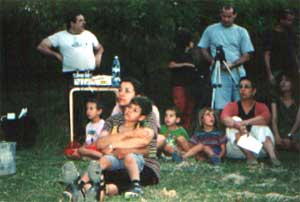
Latrun Tour 2003 (7)
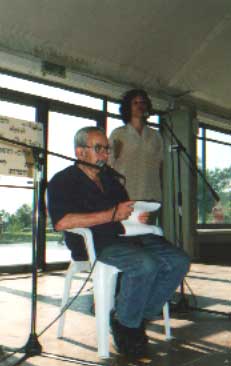
Latrun Tour 2003 (8)
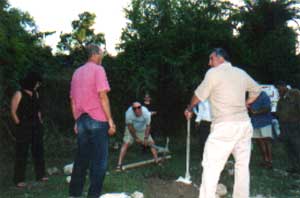
Latrun Tour 2003 (9)
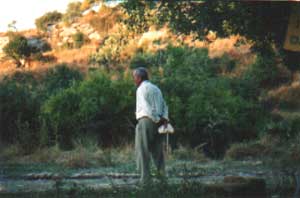
Latrun Tour 2003 (10)
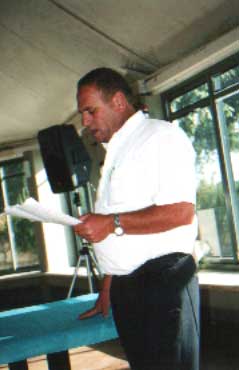
Latrun Tour 2003 (11)
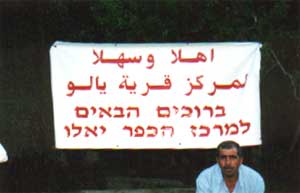
Latrun Tour 2003 (12)
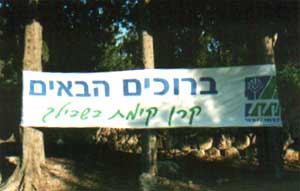
Latrun Tour 2003 (13)
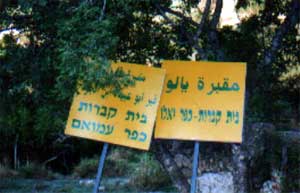
Latrun Tour 2003 (14)
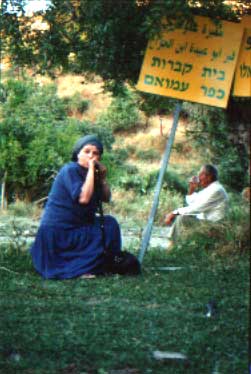
Latrun Tour 2003 (15)



